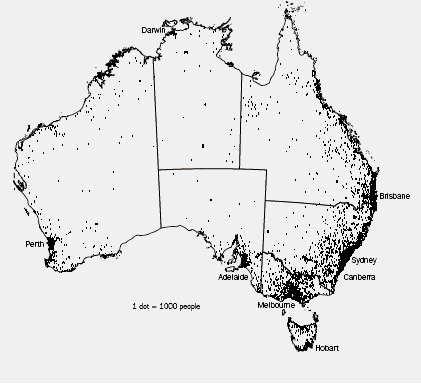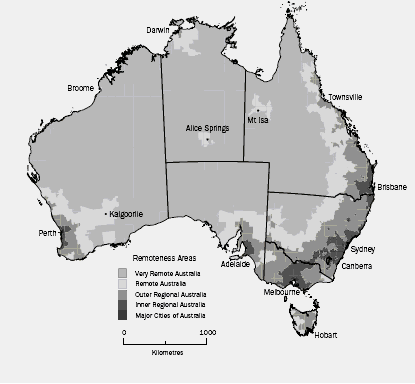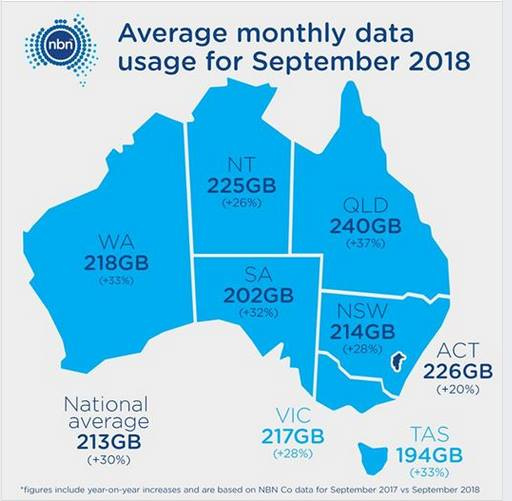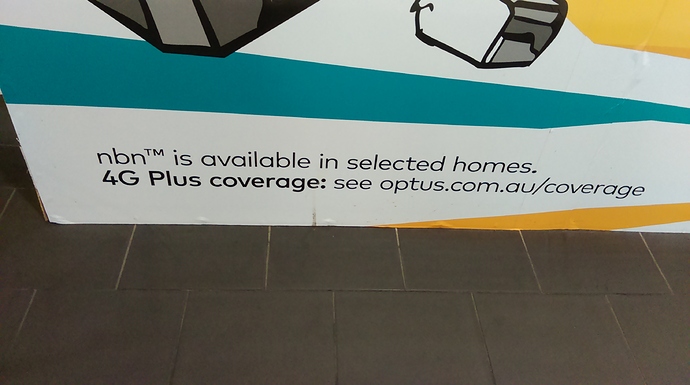Not a complaint - well, maybe a little (satellite is not a long-term solution, despite political posturing).
That article said users currently have a 45gb cap? That’s crazy! My wife would kill me if I signed up for Internet that was so much for so little. She couldn’t browse YouTube videos, or shopping websites!
Satellite is clearly not a decent solution.
I was quite happy when they increased it from 30GB/month!
For context:
It’s a reasonable band-aid. Pretending that it’s equitable to leave people on satellite indefinitely is obscene.
That map is pretty useless. When a large majority of the population lives in cities (and thus has semi-decent Internet access), it skews state-by-state figures enormously!
The first document I stumbled upon when looking for population distribution was on the ABS website. Here is a map of our population distribution from that page, with each dot representing 1,000 people (as at 2006):

The ABS figures show that major cities plus inner regional (which includes Tasmania) total 88.1% of the population. Add in places like Darwin, which is classified as ‘outer regional’, and you account for 97.6% of the population being somewhere other than ‘remote’ or ‘very remote’. Presumably some of the ‘outer regional’, which covers large swathes of the states (per below), along with most or all of those ‘remote’ and ‘very remote’ people, are intended to use on satellite. That is 2.4% of the population, or half a million people as at 2006.

Um!
2 satellites = 30GB data,
4 satellites = 60GB data,
…
16 satellites = 240GB data,
Starting to sound more equitable.
Did the NBN recently announce that they are only 50% of the way through the roll out of the Skymuster satellite service?
Um! 32 satellites? Dream on Mark.
Even just 2 more for a total of 4 anyway to keep the status quo for the service.
The NBN Co is still very busy trying to complete the task nation wide. How critical is it to also have real solutions for upgrading future services to the 20+% of all NBN customers at the bottom end of the service?
I disagree. Comparing the limited allocation on satellite with average demand is revealing.
Not seeing the relevance. Equity is equity. Australian tradition has historically tried to compensate for disadvantage.
It does raise a point that has been bothering me though. A couple of times lately, people who peddle the line that the private sector does everything better have referenced an old proposal from Telstra as evidence.
In 2005, Telstra put forward a proposal for an FttN upgrade that would have covered 75% of the population. The sad fact is that the “upgrade” was necessary, primarily because Telstra had neglected the copper infrastructure. They needed to replace most of the copper and were angling for public monies to update their privatised monopoly. They were also establishing grounds to assert that “we tried, but the government got in the way”.
75% of the population is less than live in major metropolitan areas. There was no indication that Telstra planned to build beyond the most lucrative suburbs.
Telstra did its best to torpedo any chances that the proposal had of being approved. When it was eventually rejected on equity of access grounds the plan sank, leaving barely a ripple. The industry recognised it as primarily political kite-flying.
https://whirlpool.net.au/news/?id=1656
Telstra immediately began revising the history, contending that they intended to use profits from urban markets to expand FttN into rural areas (where the customer access infrastructure was in even worse shape and technology wouldn’t have worked).
There things lay, until the mess was resurrected last year:
https://www.commsday.com/2017/10/27/some-history-on-the-nbn-debate/
The plan that Kevin Rudd took to the 2007 election is remarkably similar to that 2005 proposal. Paradoxically, the only reason it didn’t go ahead (and likely fail) was that Sol Trujillo (then CEO of Telstra) wouldn’t allow the government to use Tesltra’s monopoly customer access network. Rudd then came up with a plan to build over Telstra’s entire network - the FttP NBN.
In premises connected, perhaps.
There are no plans for more than two satellites. Lots of politics, but no plan.
Sky Muster 1 was launched in 2015. The service life of the satellite is 15 years. From proposal to launch generally takes more than a decade. There are at present no plans for replacement. Nor are there proposals to make plans. Nor proposals to discuss making plans.
Clarification?
Skymuster passed the 90,000 connected premises in Aug this year. The NBN Co target is to have 200,000 connected premises out of the 400,000 the satellites provide coverage for>
The satellite count hopefully serves to highlight the capacity needed if Australia continues to rely on satellite for NBN services. Whether you add more satellites that use similar technology or you replace the existing with new technology with ten times the capacity, as you point out it is a ten year lead time! It needs a different solution.
We both forgot to mention the cost blow out for the two we now have!
Indeed. Satellite is not a solution. It’s a stepping-stone.
Ultimately, Australia needs to push optical fibre as far as possible. The reach of a network like the NBN (or any other telecommunications infrastructure) is limited by how much can be replaced within its service life. The performance of copper wire degrades markedly after about 30 years. Much of Australia’s copper dates to the PMG era - and it shows. The anticipated service life of optical fibre is a century or more.
We did amazing things with the comparatively short-lived copper. Imagine what we could achieve with stuff that lasts three or four times as long (and incidentally costs far less). Our problem is that we need to plan at the scale of a century or more. Today’s politicians are telling us that the job will be “finished” in two years (at which point they plan to sell us out again — errr — sell it off).
We are apparently misunderstanding one another. My point was that the map you posted showing (for example) average monthly data use in the NT effectively makes unpeople of the population outside of Darwin/Alice Springs. The same with all the states - if Skymuster is limiting downloads to 45gb/month, that is:
- not represented in your map; and
- absolutely inequitable!
This is why I posted the other two maps, showing that Australia’s population is not just in a few big cities. I assume I’d be safe in saying that the half million people who are considered ‘remote’ or ‘very remote’ are almost all reliant upon satellite, while it is also likely that some people living within ‘regional areas’ would similarly be reliant upon satellite services… or tin cans.
I am very aware of how the telecoms market works, having spent some time reviewing audited financials and calculating the sums that each carrier pays to Telstra for its provision of the Universal Service Obligation. The USO has changed somewhat since that time, but the basic concept remains - equitable access to telephony for all Australians.
This obviously has to be expanded to the Internet.
Meanwhile, across the ditch:
And before anyone comes up with the obvious quibbles; New Zealand has far more challenging topography than Australia and it’s geologically far more active. Let’s just stop whining and get on with it!
I feel most of us agree about the outcomes to date from the NBN rollout.
If having your say critically is ‘whining’ there are a lot of NBN critics. Perhaps as well as sharing observations the criticism also needs to be taken directly to the local federal members and likely lead candidates for the soon to be announced Federal Election?
This time last week I attended a forum in the Glass House Mountains region organised by the local Federal Member for Fisher Andrew Wallace. It’s attendees included the Fed Minister for Communications Mitch Fifield, and the regional Managers for the NBN Co, Telstra and Optus.
There was a lot of ground covered, and of the 60 locals many were carrying virtual double barrells with concerns over mobile and phone coverage, the NBN and even old style Telstra AC pits.
There is currently a golden window of opportunity for all of us to make calls ‘to get on with it’
by using such opportunities in the current political circumstances irrespective of any partisan attachments. Many of the locals who delivered issues were known to the local member and likely conservative in their views. The impact of well known locals speaking out can be significant.
The Minister opened by stating that by abandoning the original failed NBN the govt had saved $30B of expenditure. This would have equated to in his words adding an extra $500 per year to everyone’s internet bills. An extra expense we had all been saved.
As one local pointed out the region and indeed the whole of the Sunshine Coast hinterland is dominated by mountains and forestry. There are obvious topographical reasons why solutions for communications based on other than fixed lines are challenged, and simply offering more of the same failed solutions, wireless etc is not going to deliver any better in the future.
None of the NBN issues raised were about the cost. They were typically about the service outcomes or status of the incomplete rollout. I had my minute in the spot light. This including a suggestion that if it was purely for the economics I would have been prepared to put the extra $5,000 into my service to get a fibre based solution. As our area is still in design the offer is still open. I understood from the meeting that you can submit contrary to the NBN website submit technology upgrade requests prior to service being available.
Where this might end is uncertain, but at least I have gone to the horses head. It’s up the horse now to choose if it drinks? Or donkey if you are into more biblically correct analogies in hope of a miracle. ![]()
So the minister lied. Instead of spending money on decent fibre-optic, they spent it on third-grade copper and left Telstra laughing all the way to the (probably off-shore) bank.
I will allegedly get FTTN eventually, but would prefer FTTP or even FTTC. This government is not going to fix its second-rate job, unfortunately - it just wants it finished and privatised.
I don’t know that. If you have the opportunity do ask him.
I prefer to think of the NBN as ‘World Class” alternative broadband solutions? This side steps the complex discussion on cost benefit vs viability or private vs public ownership/funding.
Reality is our property has the mark of the NBN Fixed Wireless. As we have had issues with mobile coverage we wonder if the NBN FW is even possible. FW in its present form is not an economically sustainable or viable broadband solution for our situation.
For now we have line of sight to Optus 3G/4G till the forest returns? And a working ADSL2 service, although something has forced it to half speed since they started turning FTTN on to my neighbours closer to town? A reasonable suspicion is that Telstra has turned down the power for the modem at the other end of our copper to minimise impacts on the VDSL the NBN uses? There may be a different reason, however the current 6Mbs vs prior 12Mbs is not a fault condition. I’ve tried several times and failed with my ISP to get any useful feedback.
Never! His terminology may have been strategically inexact, but would our minister lie?
We know that our government puts us first. They’ve told us so:
https://www.minister.communications.gov.au/minister/mitch-fifield/news/morrison-government-puts-telco-consumers-first
Our interests are safeguarded:
https://www.communications.gov.au/have-your-say/consumer-safeguards-review-consultation-part-consumer-redress-and-complaints-handling
and our government will deliver reliable services:
https://www.communications.gov.au/have-your-say/consumer-safeguards-review-consultation-part-b-reliability-services
All of which came after they ruined our NBN! Worse, they still want to sell it - even after the last 30 years of disastrous short-term decision-making about selling off monopolies at mate’s rates.
It’s like chopping your arm off and then offering to sell you a bandaid… for $50.
Unless/until one of the major parties in this country pledges to stop selling off their constituents’ assets in a form that I can actually believe, I’ll be voting else-wise. I just wish the Australian Democrats hadn’t imploded.
I noticed this item of Optus stupidity in a vacant shop at our local shopping centre.
I was clearly under the impression that the wired NBN network was available to all premises in areas that have had the infrastructure installed and commissioned, the NBN Fixed Wireless network was available to all premises within radio range, and the NBN Sky Muster satellite service was available to all premises who could not get the wired or wireless services.
But Optus never lets the truth get in the way.
Stupidity? Perhaps.
The NBN network won’t be “completed” until 2020. It’s therefore “available” in those homes that have been “selected” to have it installed to date. The line below that doesn’t relate to the NBN, but it looks like it does. Some people will thus be confused into signing up for Optus 4G Plus (if it’s available), in the belief that they’re signing up for NBN.
Not so much stupidity as dishonest marketing.
Perhaps I should have stated “deceptive and misleading conduct” instead of “stupidity” so as to better reflect their modus operandi.
As you pointed out, it may well be an attempt to try to mislead consumers to think their third-rate mobile network was some sort of NBN solution.
The full image of the ad in the empty shop previously occupied by one of their flunkies before they moved next to the Telstra store features an image of Usain Bolt and a message stating “We are just a 100 metre dash way” despite it being much further than that.
But never let the truth get in the way of a good story.
The NBN Co progress reports can join the same club?
Per the 8th Nov 2018 weekly progress report from the NBN Co for FW:
There were 632,992 premises ready to connect to FW with 259,190 connected. The NBN Co Corporate Plan says there are only 600,000 premises to be served by FW. So the FW network is now complete? Alternatley there are more customers in the planned FW service areas than the NBN Co could count?
According to the NBN publically released 2019-2022 NBN Co Corporate Plan
“Fixed Wireless
The Fixed Wireless program extends the nbnTM access network beyond the reach of the fixed-line footprint. Operational since 2011, the program is managed through a turn-key delivery contract with Ericsson as the primary vendor. Network deployment is almost completed, with approximately 0.6 million RTC as of 30 June 2018.“
How would you read this? Does a wireless coverage area that does not have a tower in place and does not have planning approval for a tower align with the NBN Co statement? They only have till June 2020. Optimistically there are two Xmas’s between now and then!
Sort of?
NBN Co use the terminology ‘fixed wireless coverage/service area’ .
There are NBN customers in a fixed line service area who are also in wireless range of the NBN. It is the NBN’s choice which service you get.
There are also premises that are within range based on distance from an NBN FW tower that miss out while customers further away In the same area get service. This may be due to terrain effects or cell alignment.

